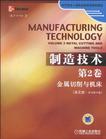制造技术 第2卷金属切削与机床
出版时间:2010-2 出版社:机械工业 作者:拉奥 页数:476 字数:763000
前言
由美国北依阿华大学(University of Northern lowa)工业技术系P N Rao教授所著的《制造技术第1卷铸造、成形和焊接》(Manufacturing Technology Volume 1 Foundry,Forming and Welding)和《制造技术第2卷金属切削和机床》(Manufacturing Technology Volume 2 Metal Cutting andMachine Tools)已经分别出版到第3版和第2版,它们已经被国外多所大学选为工程类本科学生学习制造技术的专业基础教科书。几年前,作为国外优秀原版教材,机械工业出版社引进出版了该书的前一个版本,国内部分高校已经采用它们作为“工程材料及成形技术”、“机械制造技术基础”或“制造工程基础(包括成形加工和切削加工)”等机械工程及自动化类专业核心课程的教材或主要教学参考书。该书的引进出版和教学应用,对于促进国内机械工程本科教学中更新教材、教学研究和双语教学等工作,产生了积极的重要作用。以使用本教材的教师和学生的反馈信息为基础,最新出版的这两卷书对第1卷的主要内容进行了大幅度地修订,也对第2卷的部分内容进行了调整和补充,从而使全书内容能够尽可能地反映出制造工艺与装备技术的新进展,使各章节内容更加简明和紧凑,从而更加便于教师和学生使用。第1卷修订后将原来的29章内容重新组织改写为12章,删去了以前章节中一些重复的内容;重新绘制了部分示意图,使之更加清晰和易于学生理解;增加了有关抗拉试验、激光热处理、快速原型等10余处内容,重写了钎焊的全部内容。第2卷修订后各章标题变化不大,只是将原书中第14章“工艺规划”整个一章改写为“工装与夹具”,但在具体内容上,也进行了较大的修改和补充。第2章增加了介绍涂层硬质合金的内容,第3章加强了机床传动系统及作动器方面的内容,改写了第11章“特种加工”的内容,增加了水切割等新工艺方法,第15章对摩擦学方面的通用测量设备内容进行了更新。此外,该书还别开生面地在正文之前增加了“图示预览(Visual Walkthrough)”,将该章主要内容组成,如教学目的、发展历史、图示范例、已解决的问题、小结、思考题和习题等,用图示和文字做了一个概要描述,这将帮助读者更好地利用该书各章节的内容。通过以上修订、补充和改写,使新版本制造技术的内容更加系统完整,文字更加简洁易读,图例更加清晰明了。本书不失为一套适用于我国高校机械工程及自动化以及相关专业的优秀英文原版教材和教学参考书,也适用于相关专业的专业英语教材,并可供机械工程和制造工程领域的专业技术人员学习、参考。
内容概要
本书是一本适合于我国高校机械工程及自动化以及相关专业的优秀英文原版教材,同时也不失为一本专业的教学参考书。可用于相关专业的专业英语教学,并可供机械工程和制造工程领域的专业技术人员参考。 本书侧重机械制造的基本内容,包括涂层硬质合金、机械加工技术、通用测量设备和特种加工技术四大部分。 将原书中第14章“工艺规划”改写为“工装与夹具” 增加了介绍涂层硬质合金的内容。 加强了机床传动系统及作动器方面的内容。 改写了第11章“特种加工”的内容,增加了水切割等新工艺方法。 第15章对摩擦学方面的通用测量设备内容进行了更新。
作者简介
作者:(美国)拉奥(P N Rao)
书籍目录
出版说明 序 Preface 1. Introduction 1.1 Introduction to Material Removal Processes 1.2 Variety of Machine Tools 2. Metal Cutting Objectives 2.1 Introduction 2.2 Chip Formation 2.3 Shear Zone 2.4 Orthogonal Cutting 2.5 Shear Angle and Its Relevance 2.6 Cutting Tool Materials 2.7 Thermal Aspects 2.8 Tool Wear and Tool Life 2.9 Surface Finish 2.10 Cutting Fluids 2.11 Empirical and Analytical Determination of Cutting Forces 2.12 Economics Summary References Review Questions Problems 3. Machine Tools Objectives 3.1 Introduction 3.2 Classification of Machine Tools 3.3 Generating and Forming 3.4 Methods of Generating Surfaces 3.5 Accuracy and Finish Achievable 3.6 Basic Elements of Machine Tools 3.7 Support Structures 3.8 Power Transmission 3.9 Actuation Systems 3.10 Guideways 3.11 General Work Holding Methods Summary References Questions 4. Centre Lathe Objectives 4.1 Introduction 4.2 Constructional Features of a Centre Lathe 4.3 Aids for Support and Location 4.4 Cutting Tools 4.5 Operations Performed in a Centre Lathe 4.6 Taper Turning Methods 4.7 Thread-cutting Methods 4.8 Special Attachments 4.9 Machining Time and Power Estimation 4.10 Typical Setups Summary References Questions Problems 5. Special-Purpose Lathes Objectives 5.1 Limitations of a Centre Lathe 5.2 Capstan and Turret Lathes 5.3 Automatic Lathes 5.4 Tooling Layout and CAM Design for Automatic Lathes Summary Questions 6. Reciprocating Machine Tools Objectives 6.1 Introduction 6.2 Shaper 6.3 Planing Machine 6.4 Slotter Summary Questions Problems 7. Milling Objectives 7.1 Introduction 7.2 Types of Milling Machines 7.3 Milling Cutters 7.4 Milling Operations 7.5 Dividing Head 7.6 Milling Mechanics 7.7 Milling Time and Power Estimation 7.8 Special Setups Summary Questions Problems 8. Hole-Making Operations Objectives 8.1 Introduction 8.2 Drilling 8.3 Reaming 8.4 Boring 8.5 Tapping 8.6 Other Hole-making Operations Summary Questions Problems 9. Abrasive Processes Objectives 9.1 Introduction 9.2 Grinding Wheel Designation and Selection 9.3 Types of Grinding Machines 9.4 Grinding Process 9.5 Grinding Process Parameters 9.6 Creep Feed Grinding 9.7 Honing 9.8 Lapping 9.9 Other Finishing Processes Summary Questions Problems 10. Other Machine Tools Objectives 10.1 Sawing 10.2 Broaching 10.3 Gear Cutting Summary Questions 11. Unconventional Machining Processes Objectives 11.1 Need for Unconventional Processes 11.2 Electric Discharge Machining 11.3 Electro-chemical Machining 11.4 Ultrasonic Machining 11.5 Chemical Machining 11.6 Laser Beam Machining 11.7 Abrasive Water Jet Machining Summary References Questions 12. Machine Tool Testing Objectives 12.1 Introduction 12.2 Measuring Instruments Used for Testing 12.3 Test Procedures 12.4 Acceptance Tests Summary 13. Designing for Machining Objectives 13.1 Introduction 13.2 General Guidelines for Design for Machining 13.3 Design for Turning 13.4 Design for Hole Making Operations Summary 14. Jigs and Fixtures Objectives 14.1 Introduction 14.2 Functional Surfaces 14.3 Location Principles 14.4 Locating Devices 14.5 Clamping Devices 14.6 Jigs 14.7 Designing a Jig 14.8 Fixtures Summary Questions 15. Metrology Objectives 15.1 Introduction 15.2 Tolerances, Limits and Fits 15.3 Linear Measurement 15.4 Angular Measurement 15.5 Thread Measurement 15.6 Surface Texture 15.7 Gauges and Gauge Design Summary Questions 16. Numerical Control of Machine Tools Objectives 16.1 Introduction 16.2 Numerical Control 16.3 NC Machine Tools 16.4 Part Programming Fundamentals 16.5 Manual Part Programming Methods 16.6 Computer Aided Part Programming Summary Questions Problems Index 读者信息反馈表
章节摘录
插图:Types of cutting fluids There are three basic types of cutting fluids used in metal cutting. They are Water based emulsions Pure water is by far the best cutting fluid available because of its highest heat carrying capacity (high specific heat). Besides this, it is cheap and easily available. Its low viscosity makes it flow at high rates through the cutting fluid system and penetrate the cutting zone. However, water corrodes the work material very quickly, particularly at high temperatures prevalent in the cutting zone as well as the machine tool parts on which it is likely to spill.Hence, other materials are added to water to improve its wetting characteristics, rust inhibitors, and any other additives to improve lubrication characteristics. These are also called water soluble oils. The concentrated oil is normally diluted in water to any desired concentration, such as 30 : 1 to 80 : 1. Straight Mineral oils These are the pure mineral oils without any additives. Their main function is lubrication and rust prevention. These are chemically stable and lower in cost. However, their effectiveness as cutting fluids is limited and therefore would be used for light duty application only. Mineral oils with additives (Neat oils) This is by far the largest variety of cutting fluids available commercially. A number of additives have been developed, which when added to the mineral oils would produce the desirable characteristics for the different machining situations. Many difficult to machine situations would be helped by the use of these cutting fluids. These are generally termed as neat oils.The additives generally improve the load carrying capacity as well as chemical activity. Fatty oils are generally used for adding the load carrying properties. Other class of additives termed as EP (Extreme Pressure) additives are used for more difficult to machine situations. These EP agents come into effect whenever minute highspots on the mating surfaces break through the oil film, and rub together to set up localised high temperature spots. This high temperature causes the EP additives to react with the adjacent metals, and create an anti-welding layer of solid lubricant, precisely where it is required. The layer is continuously broken by the severe rubbing action between the chip and the tool.EP additives are basically chlorine or sulphur, or a combination of both of them. As a result, the anti- welding compounds formed in the cutting zone are iron chloride and iron sulphide, both of which have very low shear strengths.
编辑推荐
《制造技术(第2卷):金属切削与机床(英文版·原书第2版)》:时代教育·国外高校优秀教材精选
图书封面
评论、评分、阅读与下载
用户评论 (总计9条)
- 本书侧重机械制造的基本内容,包括涂层硬质合金、机械加工技术、通用测量设备和特种加工技术四大部分
- 制造技术有12两本书
如果你是在机械出口行业的话~ 强烈建议你买下来 回家看看~ 一定会有很大收获 现在做出口 英文好都是次要的,重要的是专业知识强~
好书 强烈推荐 - 学习英语,希望能有别的收获
- 课程用的教材,还没用,看起来挺不错
- 刚刚收到,还没看,不过看起来不错
- 感觉比当初本科学机械时的中文教材更容易理解,不过或许跟我目前已经有基础有关系。整本书按照机械制造类型划分章节,全面系统。对于机械行业人员来说,是个学习机械英语的很好的第一本教材。
- 外表不错,内容粗粗看了一下,比较概略。熟悉英文用词是不错的。
- 如果多有些彩图说明就好了
- 国内缺少像样的如图书
